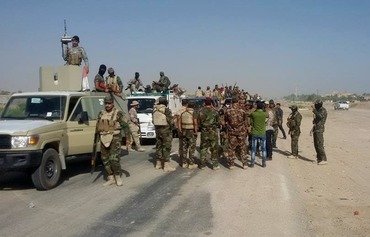The Iraqi army regained full control of Fallujah on June 26th after expelling the final remaining pockets of "Islamic State of Iraq and the Levant" (ISIL) fighters from its neighbourhoods.
The retaking of the Anbar city is a "crushing blow to the group, which was counting on not losing the city and retaining its influence there for as long as possible", said Fallujah operations commander Lt. Gen. Abdelwahab al-Saadi.
"Fallujah was a city of symbolic and strategic importance for ISIL", he told Mawtani, as it was the first to fall into the group's hands, ahead of its invasion of Mosul in June 2014.
Throughout ISIL's occupation of the city, the group used it as a springboard to threaten Baghdad's security, he said, deploying suicide bombers, car bombs and improvised explosive devices (IEDs).
ISIL elements in Fallujah committed the most heinous massacres and abuses of human rights, he added.
"Today, with the efforts and sacrifices of our courageous troops, the city has been completely freed of the filth of terrorism, and terrorists no longer hold even one inch of its territory," al-Saadi said.
A well-planned operation
The operation to liberate Fallujah lasted for more than a month, and was conducted in two stages, al-Saadi said.
During the first stage of the operation, Iraqi forces surrounded the city from all sides and secured its outskirts.
"All armed units without exception participated in this stage," he said.
"In stage two we stormed the city, and the liberation operations, which were assigned to the anti-terrorism agency and federal police forces, moved from one neighbourhood to another" clearing them of ISIL fighters, he said.
"With every advance, we cared first and foremost about how to rescue trapped civilians and ensure their safety, and we were able to evacuate them and take them all out of the city without any significant losses," he added.
Close to 1,800 ISIL fighters have been killed since the push to liberate Fallujah began on May 22nd-23rd, he said, and more than 80 car bombs have been destroyed.
Iraqi forces also seized bomb-making workshops and command and control positions operated by ISIL, al-Saadi said.
Removing mines and explosives
Iraqi forces from the Fallujah operations command are now clearing the thousands of IEDs ISIL planted in the city's streets and houses, al-Saadi said.
"We have so far completed half the work," he said. "Within days, possibly, we will finish removing and defusing all IEDs."
"The Fallujah liberation plan has realised its goals by retaking all neighbourhoods of the city," Fallujah mayor Issa al-Sayer told Mawtani.
The al-Jolan, al-Nazzal, al-Muallemeen and al-Shurta neighbourhoods were the last areas to be freed from the group, he said.
"Military engineering teams are working to defuse ISIL mines, found in significant numbers on streets, in government buildings and in private homes," he said.
The liberating forces on June 27th removed explosives from 38 houses and schools, two mosques and a water plant, the Ministry of Defence said in a statement. They also detonated 717 IEDs in various parts of the city.
"Cleaning the city of explosives and war remnants is the new challenge facing our security forces, before starting the reconstruction of infrastructure, restoring services and bringing back displaced residents," al-Sayer said.
Public facilities and services in Fallujah were not severely damaged, according to military and local officials, which could "speed up efforts to stabilise and bring back normal life to the city", al-Sayer said.
Pursuing fleeing ISIL fighters
After liberating the city, Iraqi and coalition warplanes targeted ISIL fighters fleeing Fallujah for the town of al-Hasi to the city's south-west, said Anbar provincial council security committee member Rajeh Barakat al-Aifan.
Iraqi officials said hundreds of vehicles and dozens of ISIL fighters were killed in the Wednesday and Thursday (June 29th and 30th) airstrikes, AFP reported.
Coalition aircraft destroyed at least 175 ISIL vehicles, striking two concentrations of vehicles to the city's north-west and south-west, a coalition spokesman said.
"We know the Iraqi security forces destroyed more," the spokesman said.
Iraq's joint operations command said the air force destroyed 96 vehicles and killed "a large group" of fighters, while army aviation destroyed 507 and killed "dozens" over the same period.
While the command did not provide precise figures for the number of ISIL fighters killed in Iraqi strikes, it said coalition bombing left 349 dead.
"Our forces have managed to crush ISIL's elements," al-Aifan said.
The vehicles destroyed by the Iraqi forces include "four Hummer vehicles and a booby-trapped bulldozer, in addition to saloon cars and pick-up trucks carrying machine guns", he told Mawtani.
The campaign against ISIL "will continue to terminate the gunmen's presence in that area and in the areas of Albu Elwan and Albu Aifan", al-Aifan said.
Those areas are considered ISIL's last strongholds in eastern Anbar, he said.

![Iraqi forces take photographs in the Anbar province city of Fallujah after liberating it from the 'Islamic State of Iraq and the Levant'. [Photo courtesy of the Iraqi counter terrorism agency]](/cnmi_di/images/2016/07/05/5744-Iraqi-forces-fallujah-600_384.jpg)




